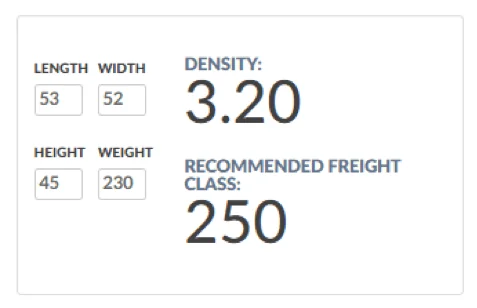
Getting Freight Class Right
Learn the importance of getting freight class right to avoid extra costs and ensure smooth shipping. Discover tips and tools to accurately classify your freight and optimize your shipping process.
Master Freight Shipping: Get Your Freight Class Right
Understanding and accurately determining your freight class is key to avoiding unexpected costs and ensuring a smooth shipping process. Freight class impacts pricing, handling, and transit times, making it a crucial factor in efficient freight management. At FreightCenter, we simplify the process with tools and expertise designed to help you classify your freight correctly every time. Whether you’re shipping pallets, machinery, or oversized goods, our resources ensure you save time, reduce costs, and ship confidently.
We provide competitive freight shipping prices and an all-inclusive, easy-to-use shipping experience for our customers. Exceeding our customers’ expectations results in thousands of satisfied customer reviews and repeat business. We believe in the power of our customer relationships. Check out FreightCenter reviews from real customers, and learn what they have to say about their freight shipping experience!
- 2021 Food Logistics’ Top Green Providers
- 2021 & 2018 Supply & Demand Chain Executives' Pros to Know: Matthew Brosious
- 2020 & 2019 Top Food Logistics’ 3PL & Cold Storage Provider Award
- 2020 & 2019 Business Observer’s Top 500 Companies on the Gulf Coast
- 2020 & 2017 SmartWay® Transport Partner
- 2020 & 2017 Food Logistics’ Champions: Rock Stars of the Supply Chain
- 2020 Best of Palm Harbor Awards for Local Businesses
- 2017 Green Supply Chain Award from Supply & Demand Chain Executive
- 2017 Tampa Bay Business Journal Heroes at Work
- 2016, 2015, & 2012 Food Logistics Top 100 Software and Technology Providers
- 2013 Tampa Bay Business 100 by Tampa Bay Business Journal
- 2013 Top 100 Great Supply Chain Partners by SupplyChainBrain
- 2012 TIA Samaritan Award Honorable Mention
What If You Don’t Know Your Shipment’s Freight Class?
If you don’t know your shipment’s freight class when using FreightCenter, you might encounter unexpected challenges, such as inaccurate shipping quotes or additional fees. FreightCenter relies on accurate freight class information to provide the best possible rates and ensure your shipment is handled correctly. Without knowing the correct class, the carrier may reclassify your shipment after it’s been picked up, which could lead to higher costs than you initially expected. This reclassification process can also cause delays in shipping, as the carrier needs to reassess the shipment before moving it forward.
To prevent these issues, it’s essential to determine the freight class of your shipment before booking with FreightCenter. FreightCenter offers tools and resources to help you accurately calculate your freight class, such as freight class calculators and expert assistance. Using these resources, you can ensure that your shipment is classified correctly, which helps you avoid surprises, handle your shipment properly, and control your shipping costs. Taking the time to get the freight class right streamlines the shipping process and provides peace of mind, knowing that everything is set up for a smooth delivery.
Importance of finding Freight Class Density
Using a freight class density calculator offers significant convenience, especially for those new to freight shipping or managing multiple shipments. This tool simplifies determining the correct freight class by doing the calculations for you. Instead of manually measuring dimensions, calculating volume, and figuring out the density, the calculator handles these steps quickly and accurately. All you need to do is input the weight and dimensions of your shipment, and the calculator provides you with the correct density and corresponding freight class. This ensures that your shipment is classified correctly, helping you avoid costly errors and ensuring a smooth shipping process.
In addition to saving time, a freight class density calculator enhances accuracy, which is crucial in shipping. Misclassifying your freight can lead to unexpected charges, delays, or even damage to your goods if they’re not handled properly. Using a density calculator minimizes the risk of these issues, giving you an accurate and reliable freight class based on standardized criteria. This helps you get the best shipping rates and builds trust with your carriers, as they can rely on the information you provide. Overall, using a freight class density calculator is a convenient and effective way to streamline your shipping operations and ensure your goods reach their destination safely and on time.
To create value for our customers by delivering customized shipping solutions that meet their unique needs and to fulfill shipping demands from simple to complex with expertise, guidance and ingenuity.
LTL shipping involves combining multiple small shipments from different customers onto one truck, allowing each customer to share the shipment cost. Trust the experts at FreightCenter to give you the best prices and the most comprehensive options for all your LTL freight shipping needs.
Truckload shipping, also known as full truckload (FTL), is a transportation option for freight that requires the entire trucks trailer space. Unlike LTL shipping, FTL shipping is reserved for larger commodities that exceed LTL weight and size limits, typically weighing more than 20,000 pounds or having dimensions that exceed 12 feet in length, 8 feet in width, and 8 feet in height. We deliver optimized solutions for full or partial truckloads and competitive dry van, flatbed, and refrigerated freight pricing. We can cover your full truckload shipping needs.
Nationwide Expedited Trucking services move your freight securely and rapidly. Your freight requires fast delivery; our freight shipping experts can get your shipment fast, whether in one large box or a full truckload.
Specialized is a transportation option for items that require specialized handling, equipment, or shipping conditions. Specialized shipments may include high-value cargo, oversized cargo, or cargo that require temperature-controlled transportation. The most reliable Specialized Freight Services rates from all the top carriers are just a few steps away. From white glove service to international shipping, we've got you covered.


You Can’t Beat the Carrier’s Technology
You’ve probably picked up on a theme here. Being inaccurate in your measurements or guessing the weight can be an expensive mistake. In all three of these examples, the billing adjustment was due to the shipper not providing accurate measurements and weight. Making your best guess isn’t good enough.
Today’s carriers employ technology that makes them exact on all their figures. Forklifts have built-in digital scales, and every piece of cargo is weighed. As for the width, length, and height of your shipment, carriers use industry-specific measuring devices that incorporate lasers and computers to instantly report your cargo’s accurate measurements. There is no way to get around the carrier’s technology. It would help if you were correct.







